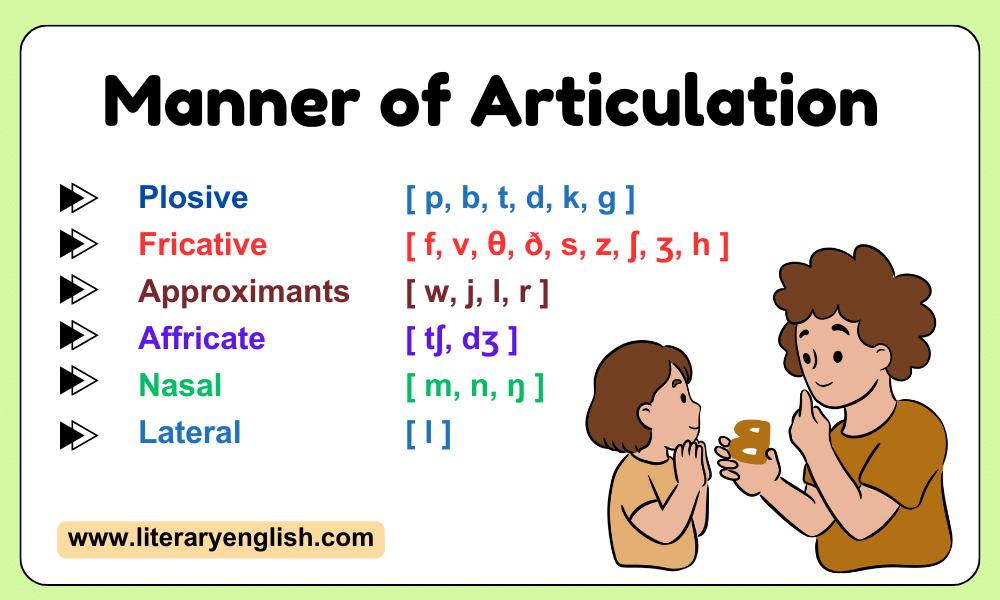Manner of Articulation
As we know that speech-sound is made when we make obstruction to the flow of the air. The level of obstruction varies from slight obstruction to full obstruction. Usually, vowel makes very little obstruction, while consonant makes high or complete obstruction. The manners of obstruction in speech sound are known as the manner of articulation.
Vowel letters do not make any clear obstructions on the other hand constant letters make clear obstructions. Therefore, we divide manner of articulation into two major types on bases of consonantal sounds.
- Obstruents: It includes stops, fricatives, and affricates.
- Sonorants: It includes nasals, liquids, and glides.
Now we will discuss manner of articulation in detail. The total numbers of sounds
- Plosives 6
- Nasals 3
- Fricatives 9
- Affricates 2
- Approximants 4
Plosive ( Stop)
Stop includes those sounds that are made by full obstruction of air in the vocal tract, and thus traditionally includes the class of plosives. Both, active and passive articulators form a structure of complete closure so that no air can pass through lips (mouth) or nasal cavity (nose). Usually it refers to a sound when a complete closure in the vocal tract is suddenly released; (as in the word [book]). Thus the sound stop occurs in two steps; the obstruction of air and sudden release of that air.
- Examples of stop are [p, b, t, d, k, and g]. Nasal stops include [m, n, and ŋ].
Fricative
When we push air through a narrow gap to create a hissing noise, we make a fricative consonant. Sometimes, this hissing sound is voiced fricative such as [v, ð, z, ʒ], and sometime it is voiceless such as [f, θ, s, ʃ, h].
- Examples of fricatives are [f, v, θ, ð, s, z, ʃ, ʒ, and, h].
Fricatives are divided into two categories (sibilant fricatives and strident fricatives depending upon clearly audible and less audible. Sibilant fricatives are strong and clearly audible such as [s, ʃ]. Strident fricatives are weak and less audible such as [θ, f].
Approximants
Approximant includes constant sounds that are created by very less obstruction to the airflow. BBC English has four approximant sounds. Usually we divide approximants into two groups:
- Semivowels with very less obstruction such as [w] in ‘wet’ and [j] in ‘yet’.
- Liquids sounds which have comparatively identifiable constriction of the airflow but not like fricative noise such as [l] in ‘lead’ and [r] in ‘read’.
Affricate
The manner of articulation in affricate is similar to plosive but it does not remain stop for a long time. Unlike plosive, the air is released slowly in affricate.
This articulation occurs when a fricative is followed by a plosive with the same place of articulation. There are two affricate in English that are [tʃ] in sound of ‘church’ and [dʒ] in sound of ‘judge’.
Nasal
When air from lungs is obstructed at some point of oral cavity and air passes through nasal cavity, it creates a very different sound. This manner of articulation is known as nasal. The examples of nasals are [m], [n] and [ŋ].
Lateral
In lateral, there is complete closure of air in the center of the vocal tracts and air flows through the sides of the tongue. The example of lateral sound is [l] as in the word ‘late’.
Trill, Tap, and Flap | Central Approximants
Tap, Trill, and Flap are also known as central approximants. Tap is up and down movement of the top of the tip of tongue. In this sound, tongue makes a single tap against the alveolar ridge. Flap is front and back movement of tongue tip at the underside of tongue with curling behind. In the production of trill the articulator is set in motion by the current of air [r].
Related Posts
- Phonetics and Branches of Phonetics
- Phonetics vs. Phonology
- Introduction to Vowel Sounds
- Introduction to Consonant Sounds
- Place of Articulation | Articulatory Gestures
- Types of Phonetic Transcription
- Tap, Flap, and Trill (Central Approximants)
- What is Co-articulation?
- Rules for English Consonants Allophones
